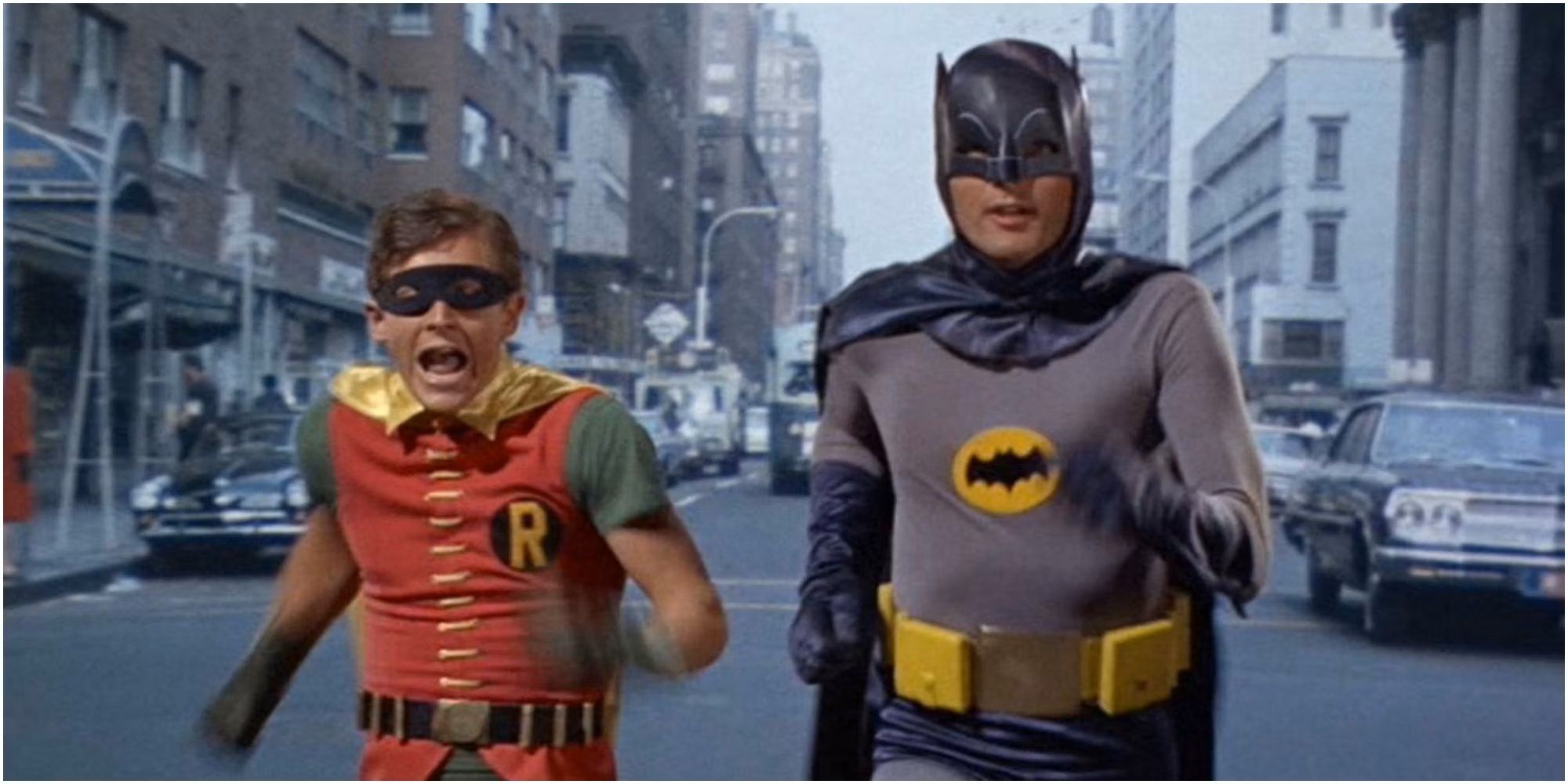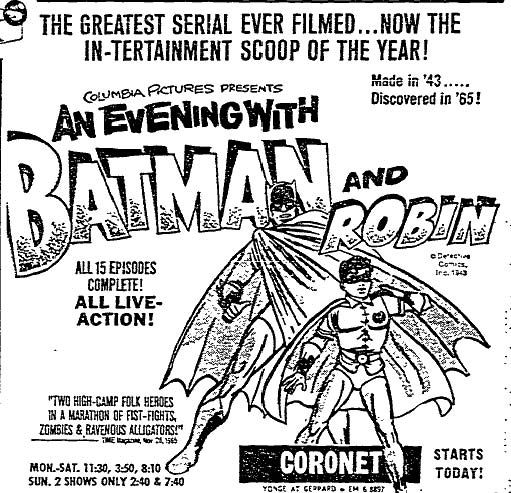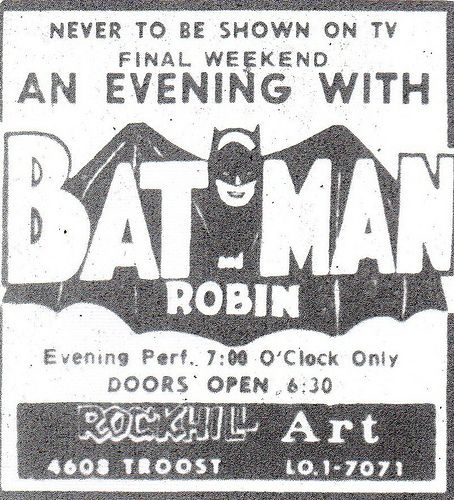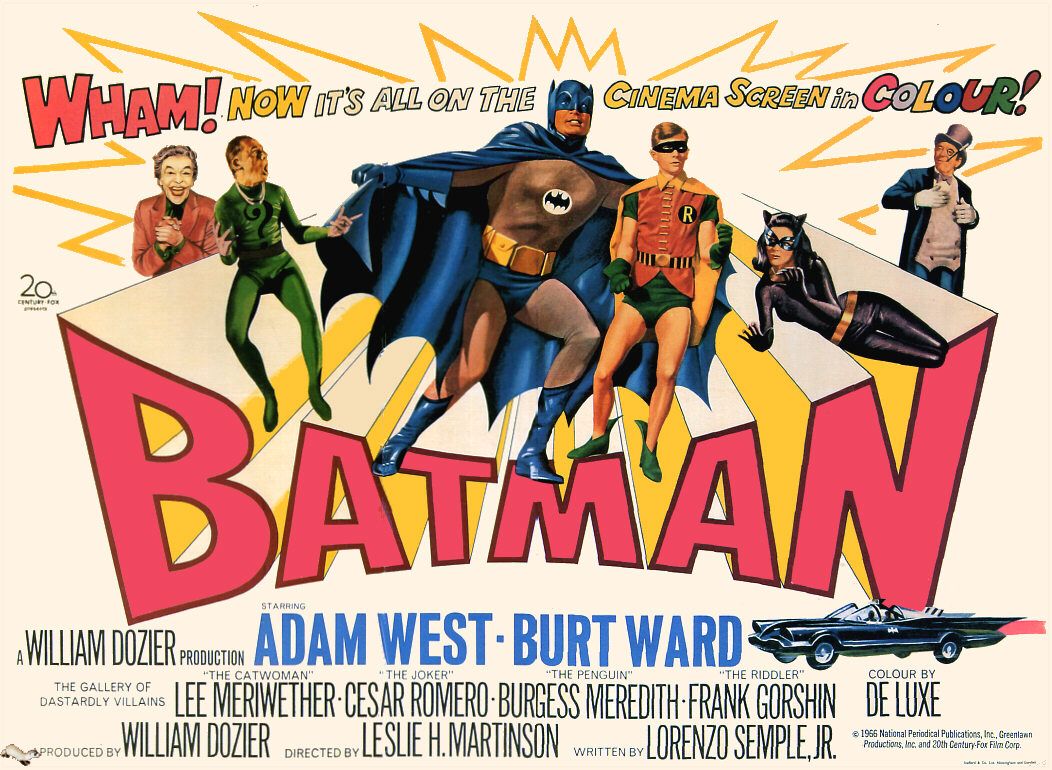TV URBAN LEGEND: The 1966 Batman TV series was almost a feature film first.
In the mid-1960s, there was a big boom in so-called "college films." In this context, college films were basically quirky stuff that college student could go watch late at night as a communal gathering-type deal. Picture the mid-1960s equivalent of The Rocky Horror Picture Show.
One of these films debuted in 1965. It consisted of splicing together all the 1943 Batman serials and release the film as "An Evening With Batman and Robin," with college students going to watch the film ironically (although I'm sure some went non-ironically)...
The films became popular and soon began playing elsewhere, including the famed Playboy Club in Chicago. While playing there, ABC executive Yale Udoff was in attendance, and he was amazed at the response by the (mostly young adult) audience.
ABC had already decided in general terms about a TV show based on a comic book character period (ABC had their eye on the 7:30 PM time slot, so early enough for kids to watch). After all, while Batman was a famous comic book character at the time of the mid-1960s, he was not NEARLY as famous as other comic characters. It was the TV series that really cemented Batman's popularity.
When ABC did a poll of probable viewers to see what comic characters they'd like to see, here is how they shook out, according to William Dozier, executive producer of the Batman TV series:
They had Superman, Dick Tracy, Batman, Green Hornet, and Little Orphan Annie. Superman was the number one choice; Dick Tracy was the number two choice, Batman three, Green Hornet four, and Little Orphan Annie five. They couldn’t get the rights to Superman, not because of the old George Reeves series, because their rights had long since evaporated, but because there was a Broadway show called It’s a Bird, It’s a Plane, It’s Superman, and that is what stopped them. They couldn’t get Dick Tracy, because Chester Gould was in some kind of peripheral negotiations with NBC, which never came to anything.
So that, combined with Udoff's strong recommendation, led to ABC executives Harve Bennett and Edgar J. Scherick going with the series.
WAS BATMAN GOING TO BE A MOVIE FIRST?
ABC hired 20th Century Fox Television to produce the series and Fox, in turn, hired Dozier to be the active producer of the show. This was now around August 1965, and ABC was so interested in the show that it purchased it before even seeing Adam West screen test AS Batman, that's how confident the network was in the concept. However, that purchase then seemed like a bad idea when the pilot was tested, and it tested TERRIBLY with audiences.
The network even tried a version with a laugh track, even considering an introduction (I'm unsure if the introduction was ever actually tested) explaining the premise of the show to the audience, letting them know that this was meant to be campy. Dozier once noted, “Reviews for it were bad if ABC hadn’t already brought the show it would of never gone on the air.” Luckily, since ABC was pot committed, it decided to simply promote the heck out of the show and, obviously, that worked.
Dozier initially wanted Fox to produce a Batman feature film, which could serve to introduce the characters and the concept and then have the movie air in the Summer of 1966 and then launch the series in the Fall of 1966. The higher budget of the movie would allow him to have certain vehicles built that couldn't be fit into the budget of a TV show (and Batman the TV show was already an extraordinarily expensive TV show).
WHY DIDN'T BATMAN COME OUT AS A MOVIE FIRST?
However, there were two problems with that approach. The first was that ABC's Fall 1965 lineup was performing so poorly that the network decided to do what it called a "second season," debuting a bunch of new shows at midseason in January and Batman was a big part of that launch, as ABC had also decided to split the show into two half-hour shows, thus helping ABC plug multiple holes on its schedule. Since it couldn't wait, the show had to debut in January 1966 and thus a movie coming first would not be feasible.
Secondly, and perhaps most practically, Fox was willing to produce the show for ABC, but obviously that meant that the show costs were paid for by ABC. A movie, on the other hand, would be covered by Fox entirely and, again, Fox was not interested in funding something that could easily flop, especially since it was testing so terribly, so Fox said no to the film (it is likely that the film plans were squelched before the pilot was even finished, honestly, so testing might not have played a role in the film being turned down).
Of course, once the show was a massive hit in early 1966, Fox gladly greenlit a feature film to be aired when Dozier wanted the original film to air, but now it would be set after Season 1 of the show. The film was also planned to be a way to sell the Batman concept to England for TV licensing there (but, as it turned out, the show was such a huge hit in the States that the UK was demanding the show before the movie even aired).
Sadly, Julie Newmar injured her back soon before the production on the film was to begin, so Lee Meriwether had to step in for her as Catwoman.
Oddly enough, the Batman movie was ultimately a bit of a bust. Dozier would later note the same thing that other, similar, film disappointments (like Glee: The 3D Concert Movie) discovered, which was that it was difficult to get people to pay to go see something they already watch for free on TV.
The legend is...
STATUS: True
Be sure to check out my archive of TV Legends Revealed for more urban legends about the world of TV. Click here for more legends specifically about superhero television shows.
Feel free (heck, I implore you!) to write in with your suggestions for future installments! My e-mail address is bcronin@legendsrevealed.com.




